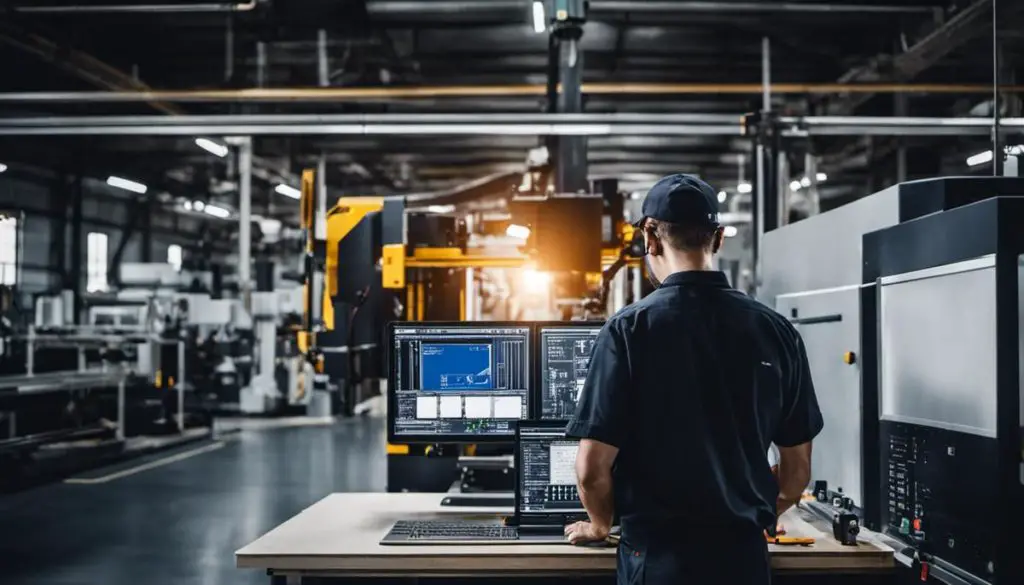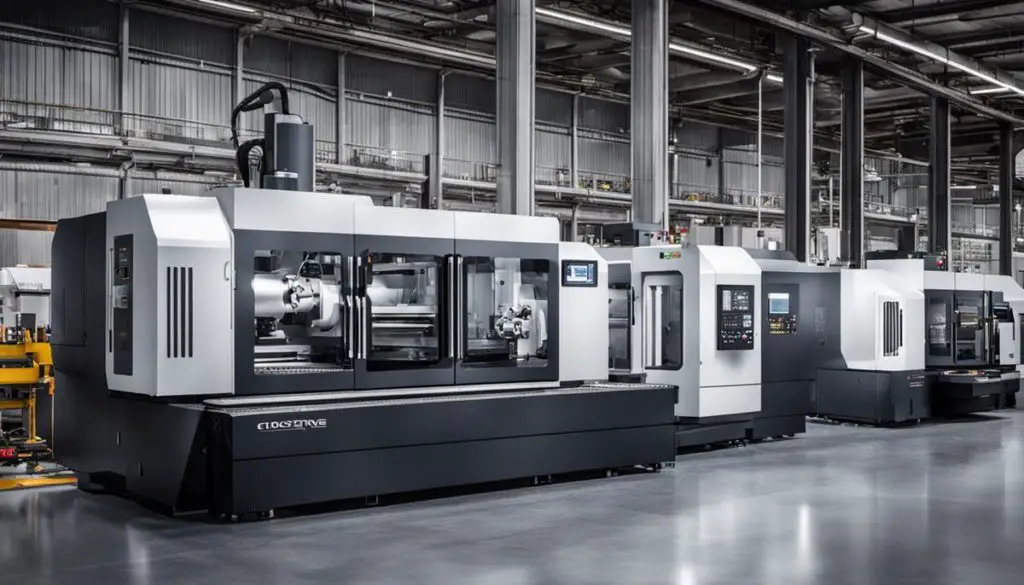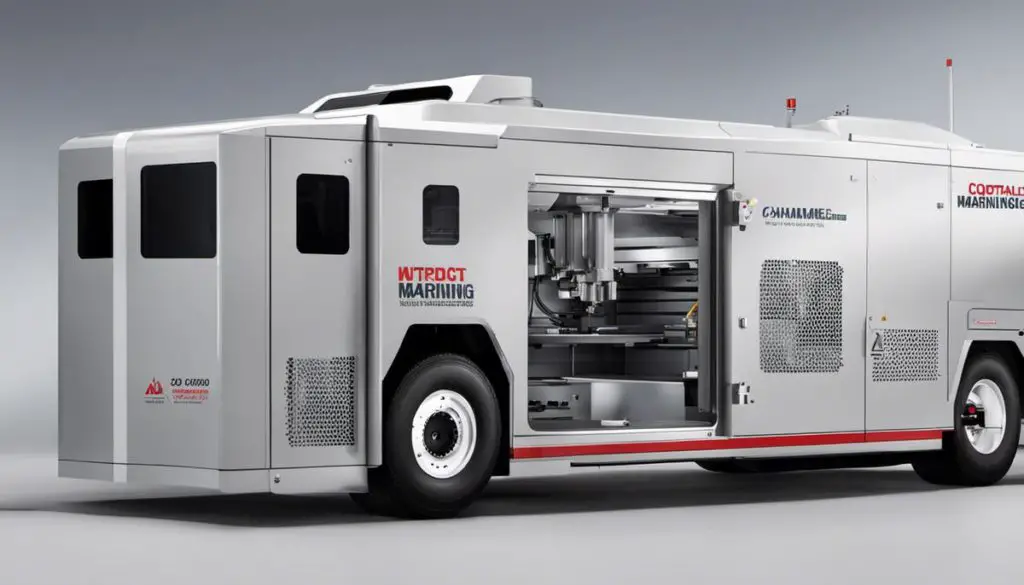
As we stand poised at the cusp of a technological revolution, the impact of Industry 4.0 on various sectors, including Computerized Numerical Control (CNC) machining, is becoming increasingly pertinent. Industry 4.0, a term coined to refer to the fourth industrial revolution, encompasses key technological advancements such as connectivity, automation, machine learning, and real-time data. These advancements have had a profound effect on the general production procedures, the global economy, and industries at large. The capabilities of CNC machining, integral to contemporary manufacturing strategies, have also been significantly enhanced, leading to unprecedented levels of productivity and efficiency in production. This examination seeks to shed light on the complex interplay between Industry 4.0 and CNC Machining, while also recognizing the potential challenges and providing viable solutions.
Key Takeaways are:
- Industry 4.0 and CNC Machining: Industry 4.0 and CNC machining are closely intertwined, with CNC machining playing a crucial role in the transition from traditional to autonomous manufacturing. The integration of these two concepts opens a world of unparalleled possibilities.
- Smart Factories: At the core of Industry 4.0 is the concept of ‘smart factories’, characterized by increased automation, interconnectivity, machine learning, and real-time data. These factories are equipped with technologies such as IoT, IIoT, cloud computing, and AI, which enable machines to act without human intervention, promoting efficient and flexible processes.
- Evolution of CNC Machining: CNC machining has evolved from simply automating machine tools to becoming the backbone of IoT and IIoT technologies. It now includes real-time communication, data analytics, cloud computing, and AI-powered predictive algorithms, making it a vital piece in the mosaic of Industry 4.0.
- Interplay between Industry 4.0 and CNC Machining: The integration of Industry 4.0 and CNC machining has profound implications for job design and labor-market structures. Instead of posing a threat to labor markets, the synergy creates new and advanced roles within the industry, shifting job prospects towards workers with sophisticated tech skills.
- Challenges and Solutions: The fusion of Industry 4.0 and CNC machining presents challenges of interoperability, security, skill shifts, and logistical adjustments. However, by prioritizing standardization, investing in cybersecurity measures, and stimulating the growth of the tech-skilled workforce, manufacturers can embrace the transformative potential of this tech-genic industrial revolution.
Concept of Industry 4.0
Unveiling Industry 4.0: A New Epoch in Technology Revolution
Industry 4.0 represents a significant and transformative shift in the way we perceive manufacturing and industrial practices. Often referred to as the ‘Fourth Industrial Revolution’, this concept embraces a radical departure from traditional systems, characterized by an increase in automation, interconnectivity, machine learning, and real-time data.
At the core of Industry 4.0 is the concept of ‘smart factories‘. These factories are technologically equipped with key principles such as interoperability (machines, sensors, and devices connecting and communicating with each other), information transparency (systems creating a virtual copy of the physical world through sensor data), technical assistance (systems supporting humans in carrying out tasks), and decentralized decision-making (ability for cyber-physical systems to make simple decisions on their own).
Application of these principles allows Industry 4.0 to redefine the concept of supply chain and production line efficiency. It enables a seamless link of the physical and digital worlds, accelerating operations, minimizing error, improving productivity, and ultimately driving profit margins.
However, as a technology enthusiast, the real excitement of Industry 4.0 lies in the disruptive technologies it pioneers. Automation and data exchange technologies reign supreme here. They include Internet of Things (IoT), Industrial Internet of Things (IIoT), cloud computing, cognitive computing, and artificial intelligence – all under the closely watched auspice of cybersecurity, which is paramount in an interconnected ecology.

Connected devices powered by IoT and IIoT technology endow factories with ‘intelligence’, enabling machines to act without human intervention; promoting efficient and flexible processes. Meanwhile, cloud computing bolsters system-wide accessibility, while cognitive computing and AI enhance decision making in real time.
It’s essential to understand that Industry 4.0 is not an “all or nothing” game. Companies stand in varying degrees of readiness. Some are fully digitalized and automated, largely bending towards the Industry 4.0 paradigm, while others still function on semi-digital platforms.
The adoption of Industry 4.0 concepts carries implications far beyond production efficiency. It affects everything from job design, skills requirement, labor-market structures, inequality patterns to new business models. While the potential of jobs loss due to automation fuels apprehension, it also showcases a promising trend of new job creation requiring upskilled workers.
To conclude, unifying the physical and digital domains, Industry 4.0 is ushering in an exciting era of hyper-connectivity and ultra-efficiency. It’s a revolution that’s transforming industries, changing the economic landscape and redefining the future of technology adoption. Industry 4.0 isn’t an event on the horizon; it’s happening right here, right now, and it’s a fascinating time to be a technology enthusiast.
Specifics of CNC Machining
The Pivotal Role and Evolution of CNC Machining in Production Lines
One can’t simply talk about the Fourth Industrial Revolution or Industry 4.0 without acknowledging the crucial role CNC (Computer Numerical Control) machining has played in manufacturing dynamics. As an integral part of modern production lines, CNC machining is the cornerstone of smart factories and forms a quintessential part in the transition from traditional to autonomous manufacturing.
In the early days when production lines were manually controlled, CNC machining introduced the concept of automating machine tools. The process was simple but revolutionary – by using computers executing pre-programmed sequences of commands. The implementation significantly increased efficiency, reduced chances of human errors and made bulk manufacturing a breeze.
With advancements in technology, CNC machining took a giant leap forward. It ventured into realms of IoT and IIoT, situated as the backbone of these technologies that bridged the gap between hardware and software. By employing real-time communication, data analytics and cloud computing, CNC machines could self-optimize, make decisions, and even learn from their past results, truly epitomizing the vision of smart factories.
Interestingly, CNC machining didn’t confine itself to the shop floor. It took a step further by offering simulations that existed solely in the realm of cognitive computing before. Leveraging AI-powered predictive algorithms, CNC systems now can predict potential faults and calculate optimal machining parameters for unprecedented efficiency. This combination of physical execution with digital analysis and prediction makes CNC machining a vital piece in the mosaic of Industry 4.0.

Despite the high degree of automation CNC machining brings, it doesn’t imply a direct threat to traditional job designs or labor-market structures. Instead, it means a shift in skills requirement towards more technologically inclined roles that can maximize the efficiency of these sophisticated machines.
As we delve deeper into this era of hyper-connectivity and ultra-efficiency, CNC machining continues to evolve. The emergence of 5-axis CNC machining and CNC laser cutting technology offers us a glimpse of the endless possibilities.
To better prepare for the future, the understanding and anticipation of this evolution is non-negotiable. As is evident, CNC machining has not only become the unsung hero of the production lines but also serves as the linchpin to the seamless unification of physical and digital domains.
CNC machining, in its various iterations, has substantially disrupted and advanced various industry domains, proving to be a revolutionary force in the continuous evolution of Industry 4.0. As we embrace the future, the role of CNC machining in production lines is destined to be even more pronounced and influential. It’s not just about keeping up with the times – it’s about advancing them.
Interplay between Industry 4.0 and CNC Machining
As the discourse on the Fourth Industrial Revolution is in full swing, the precision world of Computer Numerical Control (CNC) machining is also progressively making strides in this new era. CNC Machining, which refers to the automation of machine tools using computers executing pre-programmed sequences of machine control commands, is inherently integrated into the fabric of Industry 4.0. It’s an essential cog in the wheel of modern manufacturing dynamics, offering advanced precision, efficiency, and seamless integration with other smart technologies.
The partnership between Industry 4.0 and CNC Machining is an enticing premise. When paired with Industry 4.0’s guiding principles, CNC machining steps into a larger realm, gaining a new dimension of efficiency and agility. From hyper-accurate tooling to extensive material options and from rapid prototyping to large scale production, the merging of these two cutting-edge concepts opens a world of unparalleled possibilities.
The magic happens when technologies such as IoT and IIoT, fundamental to Industry 4.0, are integrated with CNC machinery. The machines begin to take on ‘smart’ characteristics. For instance, these ‘smart’ CNC machines can carry out real-time data collection, remote monitoring, predictive maintenance, and even self-correction, signaling a shift from being simple fabrication tools to becoming interconnected nodes in a larger manufacturing ecosystem.
These systems are not just connected; they are intelligent. Stepping into the realm of AI (Artificial Intelligence), these smart CNC machines break away from the old norm of reactive procedures to proactive and predictive operations. Through AI, CNC machines can learn and enhance their performance over time by processing and learning from historical operation data. They can even tackle defective components, improving throughput and minimizing waste. The bottom line? A significant boost in operational efficiency and a substantial reduction in maintenance costs.

For professionals within the industry, it’s important to look beyond the familiar boundaries of CNC machining. It’s not just about the machine anymore; it’s about the vast network it’s a part of. As 5-axis CNC machining, CNC laser cutting technology, and similar advancements become the new normal, embracing this intricate relationship between CNC machining and Industry 4.0 is vital.
The integration holds incredibly profound implications for job design and labor-market structures. Instead of posing a threat to labor markets, the synergy creates new and advanced roles within the industry. With an ever-increasing need for skilled workers to operate and monitor these smart machines, job prospects shift towards workers with sophisticated tech skills. It’s high time for industries to align their workforce practices with these evolving technologies.
In conclusion, as the wheels of technological advancement move forward, CNC machining is at the helm, driving and reshaping the manufacturing industry. As the fields of Industry 4.0 and CNC machining continue to coalesce, one can anticipate a future of unprecedented production efficiency, transformative business models, and restructured labor markets. At the heart of it all, the integration of CNC machining and Industry 4.0 promises a future where precision, efficiency, and innovation are at the forefront of manufacturing dynamics.
Challenges and Solutions in the Fusion of Industry 4.0 and CNC Machining
With the sweeping developments of Industry 4.0 and the impressive strides made by CNC machining, one can’t help but gaze at the horizon of boundless opportunities. But as with every technological leap, transitioning isn’t without challenges. Analyzing these hurdles and finding effective solutions is a necessary step toward harvesting the full potential of this brave new industrial world.
A prominent challenge arises in developing system interoperability. Manufacturers often grapple with integrating disparate systems. CNC machines, IoT devices, and cloud computing platforms must efficiently communicate and seamlessly function together for the smart factory to operate optimally.
Achieving this, accentuates the need for standardization of interfaces and protocols across these varying technologies. Developing universal standards that facilitate this cross-platform communication involves intense technological innovation and active engagement from stakeholders in the manufacturing sector.
Moreover, the integration of multi-layered digital systems escalates the risk of cybersecurity breaches. As a result, manufacturers must invest heavily in robust cybersecurity measures to protect valuable company and client data from malicious attacks. Implementing these complex security protocols takes time, expertise, and financial resources, but it’s a task manufacturers can’t afford to sidestep in this hyper-connected world.

As machines become smarter, skill requirements in the labor market sway towards high-level tech savvy competencies. The traditional skill sets associated with a career in manufacturing don’t cut it anymore. Not when CNC machines autonomously correct for errors and IIoT devices optimise the production line.
Therefore, investing in training and education has become indispensable. Upskilling the existing workforce and re-educating aspiring professionals to equip them with tech skills will be paramount. Tech-driven positions, such as data scientists and AI specialists, will start playing key roles in manufacturing.
The digital transformation of manufacturing also presents logistical challenges. Adopting new processes inevitably disrupts existing ones, and it may take time to anchor smooth workflows once these digital technologies are adopted.
In overcoming these hurdles, a gradual, systematic integration strategy seems prudent. Rather than overhauling the entire process at once, companies can implement one change at a time, securing a more measured, controlled adjustment.
Furthermore, collaboration holds the key to efficacious optimization. Manufacturers should aim to partner with top-level tech providers. Leveraging their expertise will facilitate the successful integration of disruptive technology.
In conclusion, integrating Industry 4.0 and CNC machining presents challenges of interoperability, security, skill shifts, and logistical adjustments. However, by prioritizing standardization, investing in cybersecurity measures, and stimulating the growth of the tech-skilled workforce, manufacturers can take a significant stride towards embracing the transformative potential of this tech-genic industrial revolution.
As we step deeper into the digital age, it’s unquestionable that the integration of Industry 4.0 and CNC Machining is the future of manufacturing. This fusion not only promises to revolutionize production lines but also holds possibilities of creating Smart CNC machines, setting new benchmarks for efficiency and productivity. But like any innovation, it brings forth its set of risks and challenges. Security threats, staff training, and development of state-of-the-art software applications are the hurdles that industries have to overcome when navigating this dynamic landscape. Through understanding and embracing these challenges, the manufacturing industry can harness the unparalleled power of this synergy, ensuring a sustainable and thriving future.

